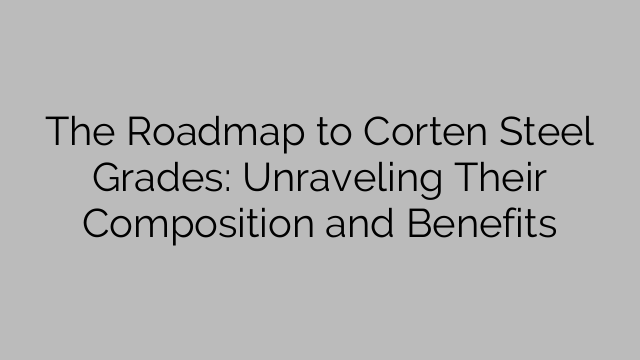Corten steel is a group of steel alloys that form a weather-resistant layer on their surface when exposed to the elements. This natural rust-like phenomenon is known as patina, and it acts as a protective barrier against further corrosion. The patina layer not only enhances the visual appeal of corten steel but also prevents the internal structure from deteriorating.
The composition of corten steel grades varies slightly, but they all primarily consist of iron, chromium, copper, and nickel. The exact ratios of these elements differ, leading to distinct characteristics of each grade. Some popular corten steel grades include ASTM A588, A606 Type 4, A242, A709-50W, and A847.
ASTM A588 is the most commonly used corten steel grade in architectural applications. It has a high tensile strength, offering excellent resistance to atmospheric corrosion. The inclusion of copper, nickel, and chromium enhances its corrosion resistance even further. ASTM A606 Type 4 is another grade with similar properties, but it also contains vanadium and phosphorus, making it even more durable in harsh environments.
Corten grades like A242 and A709-50W are primarily used in structural applications such as bridges and buildings. These grades possess high tensile and yield strength, with the addition of copper, nickel, and chromium for improved corrosion resistance. They can withstand heavy loads and extreme weather conditions, making them ideal for long-lasting structures.
A847 corten steel grade, often referred to as “Tube & Pipe,” is specifically designed for architectural applications like outdoor sculptures and construction of decorative elements. Its composition includes copper, nickel, and chromium, but it is notable for its high weldability and formability. A847 corten steel is known for its flexible nature, enabling architects to create intricate designs and shapes.
One of the significant benefits of corten steel is its low maintenance requirements. The patina layer that develops on the surface of corten steel serves as a self-protecting barrier. This eliminates the need for painting or coating the material, saving both time and money. This characteristic makes corten steel an attractive option for architectural projects where regular maintenance may be challenging.
Additionally, corten steel is an environmentally friendly choice. The self-regenerating patina layer reduces the need for replacing the material frequently, resulting in less waste and a lower environmental impact. Its durability ensures a long lifespan, making it a sustainable option for various applications.
Furthermore, corten steel offers exceptional resistance to corrosion. The patina layer acts as a shield, protecting the steel from the harmful effects of moisture, oxygen, and other atmospheric elements. This corrosion resistance makes corten steel particularly suitable for outdoor structures exposed to harsh weather conditions or corrosive environments.
In conclusion, corten steel grades possess unique compositions and benefits that make them highly desirable for architectural and industrial applications. The various grades cater to different needs, from structural strength to formability and aesthetic appeal. With its low maintenance requirements, environmental friendliness, and exceptional resistance to corrosion, corten steel is a durable and sustainable choice for those seeking longevity and architectural beauty in their projects.
[ad_2]

